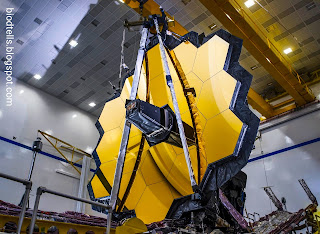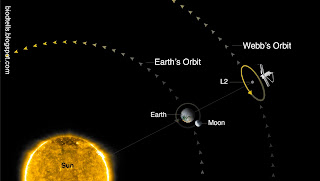How James Webb Telescope Work and will look to the past?
The James Webb Space Telescope (JWST) is a area telescope developed by using NASA with contributions from the European Space Agency (ESA) and the Canadian Space Agency (CSA). The telescope is known as after James E. Webb who turned into the administrator of NASA from 1961 to 1968 and accomplished an important function in the Apollo program. It is meant to be successful the Hubble Space Telescope as NASA's flagship project in astrophysics. JWST used to be launched December 25, 2021 on Ariane flight VA256. It is designed to furnish accelerated infrared decision and sensitivity over Hubble, viewing objects up to 100 instances fainter and will enable a vast vary of investigations across the fields of astronomy and cosmology, which includes observations up to redshift z≈20 of some of the oldest, most distant, activities and objects in the Universe such as the first stars and formation of the first galaxies, and permitting distinct atmospheric characterization of potentially habitable exoplanets.
How does James Webb Telescope work?
The James Webb Telescope is an infrared telescope, It is predicated on infrared radiations to come across items in space. It might be gazing the celestial our bodies such as stars, nebulae, planets which might be in a demise state because of being old. These planets, stars and nebulae are too cool to be discovered in the seen light. This is why they may be not seen to the human eye.
Infrared radiations are not able to pass thru gas and dust which would thus appear opaque to the human eye. Hubble telescope alternatively sees in the seen light and ultraviolet radiations and near-infrared radiation.
 |
Once in space, the telescope that is tightly folded inside the payload bay of an Ariane 5 rocket would become independent from its launch vehicle. The telescope as soon as would cross the moon unfurl to travel its decided vacation spot executing one of the most complicated deployment sequences ever attempted.
Why James Webb Telescope matters :
NASA's James Webb Space Telescope is wholly deployed in space, and it need to be able to operate its science for a long time to come.
Why it matters: The longer the JWST can perform its science, the greater data it can accumulate about the evolution of the universe. The $10 billion house telescope is the successor to the Hubble Space Telescope, which has been in space for extra than 30 years. Catch up quick: NASA completed the closing foremost deployments that unfolded the telescope closing weekend. Now, the JWST desires to make it out to its perch about 1 million miles from Earth to really start its scientific work. If all continues as planned, it have to commence its science about halfway thru the year. The successful completion of all of the Webb Space Telescope’s deployments is historic,” Gregory Robinson, JWST software director at NASA headquarters, said in a statement. This is the first time a NASA-led mission has ever attempted to complete a complicated sequence to unfold an observatory in space — a extraordinary feat for our team, NASA, and the world.
What is James Webb Telescope?
NASA's James Webb Space Telescope (JSWT) is an infrared space observatory that released on Dec 25, 2021, from ESA's launch site at Kourou in French Guiana, at 7:20 a.m. EST (1220 GMT; 9:20 a.m. nearby time in Kourou), on board an Arianespace Ariane 5 rocket.
The $10 billion James Webb Space Telescope — NASA's biggest and maximum effective space technology telescope — will probe the cosmos to discover the history of the universe from the Big Bang to alien planet formation and beyond. It is certainly considered one among NASA's Great Observatories, massive space gadgets that consist of the likes of the Hubble Space Telescope to look deep into the cosmos.
It will take about 30 days for the James Webb Space Telescope to tour almost a million miles (1.5 million kilometers) to its everlasting home: a Lagrange point — a gravitationally stable vicinity in space. The James Webb Space Telescope will orbit the sun at the 2nd Lagrange point (L2). L2 is a spot in area near Earth that lies contrary from the sun; this orbit will permit the telescope to remain in line with Earth as it orbits the sun. It has been a famous spot for a number of different space telescopes, along with the Herschel Space Telescope and the Planck Space Observatory.
The James Webb Space Telescope is the product of an dazzling international collaboration between NASA, the European Space Agency (ESA), and the Canadian Space Agency. According to NASA, the JWST worried over 300 universities, organizations and groups throughout 29 U.S. states and 14 countries. The nominal duration for the James Webb Space Telescope is five years but the purpose is 10 years According to ESA.
Who is James E. Webb?
James Edwin Webb (October 7, 1906 – March 27, 1992) became an American government legit who served as Undersecretary of State from 1949–1952. He was additionally the second appointed administrator of NASA from February 14, 1961, to October 7, 1968. Webb oversaw NASA from the start of the Kennedy administration via the cease of the Johnson administration, for that reason overseeing every of the important first crewed missions for the duration of the Mercury and Gemini applications till days earlier than the launch of the primary Apollo mission. He additionally handled the Apollo 1 fire.
Mission of James Webb Telescope :
NASA launched the James Webb space telescope on December 25, 2021 and what observed have been a sequence of deployments for it to take shape. Last Saturday, the Webb finished its final deployment which was of the number one mirror. What stays now, well actually starts is the project of the James Webb telescope.
The James Webb Space Telescope is an infrared observatory that will complement and extend the discoveries of the Hubble Space Telescope, with longer wavelength coverage and greatly improved sensitivity.
The James Webb Space Telescope has 4 key goals:
to look for light from the first stars and galaxies that shaped in the universe after the Big Bang
to examine galaxy formation and evolution
to understand star formation and planet formation
to have a look at planetary structures and the origins of life
Webb's last vacation spot is referred to as the 2nd Lagrange factor or L2 which is placed 1.5 million kilometers away from Earth. The telescope will function a third mid-course correction burn which is one of three planned to vicinity it precisely in orbit around L2. Here, the telescope will orbit the solar whilst staying in line with Earth. The telescope will additionally be blanketed by using the sun’s radiation and different sources of heat and light through the sunshield that will maintain the gadgets cool sufficient to operate.
The telescope used to be launched with slightly much less velocity than wanted to attain its last orbit, and will additionally gradual down as it travels away from Earth, in order to attain L2 with solely the velocity wished to enter its orbit there. The flight consists of three deliberate route corrections to regulate its pace and direction. This is due to the fact the observatory can recover from underthrust (going too slowly), however ought to not recover from overthrust (going too fast) - to protect relatively temperature-sensitive instruments, the sunshield should continue to be between telescope and Sun, so the spacecraft can't turn round or use its thrusters to slow down.
Prior to arriving at the ultimate spot, the James Webb telescope will first arrive at its insertion point which is anticipated to take region on January 23. From here, it will hearth its engines to journey to the Lagrange Point. At the same time, the Webb crew will also prepare to align the 18 hexagonal reflect segments of the telescope’s predominant mirror. This alignment is predicted to take months to complete, and after which the telescope will be geared up to produce the first set of images.
Webb's first set of pix are expected to include objects such as stars and the Large Magellanic Cloud which is a satellite tv for pc galaxy of the milky way. These pix will also showcase the telescope’s four science instruments. The period of the mission will be 5 years but NASA has saved a goal of 10 years.



Post a Comment